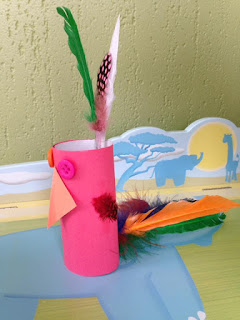Birds: Part 3
Today was a day for bird crafts. We were feeling creative.
Books
- Beaks! by Sneed B. Collard III
- Amazing Life Cycles: Birds by Brenda Williams
- The Beak Book by Pamela Chanko
- Just a Baby Bird by Mercer Mayer
- Wild About Michigan Birds by Adele Porter
Activities

- Activity: Bird sounds. While looking through Wild About Michigan Birds, we looked up the sounds that the birds made. Evie tried to mimic the sounds. The site we used: https://www.bird-sounds.net/ While we were outside, we tried to identify the bird calls around us.
- Craft: Paint a birdhouse. Purchased a wooden birdhouse from a craft store. Let Evie choose the paint colors that she wanted to use, and sat with her to decorate the birdhouse. Once it dried, she played with it, putting "eggs" (beads and rocks) inside.
- Craft: bird mobile. Materials: clear beading twine, craft feathers, stick, fake birds (from Dollar Tree), yarn. We found a stick, then took one long piece of yarn and tied one end to each end of the stick (to hang the mobile by). Then, Evie picked out some feathers that she wanted to hang from the stick, and we tied them with the clear twine at different lengths along the stick. The last step was to clip on the birds. Then, we hung our mobile in a window.
- Outdoor play: build nests out of sticks. This is the same concept as our earlier building of the eagle's nest. This time, though, we built several small nests in different places around the yard. You don't realize how difficult it must be to build a nest until you try to do it yourself. And we have hands! Somehow birds do a much better job with just their beaks. Then we talked about what dangers a bird has to consider when building a nest, such as predators and the weather. We also put together a "natural play area" while we were outside, using stumps, logs, and large branches that had been knocked out of the trees from a wind storm.













































